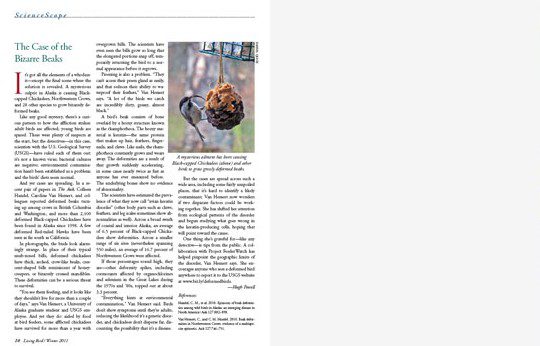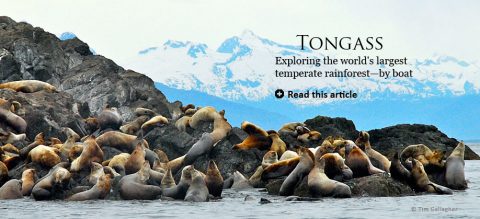The Unsolved Case of the Bizarre Beak Deformities
By Hugh Powell
January 15, 2011
It’s got all the elements of a whodunit—except the final scene where the solution is revealed. A mysterious culprit in Alaska is causing Black-capped Chickadees, Northwestern Crows, and 28 other species to grow bizarrely deformed beaks.
Like any good mystery, there’s a curious pattern to how the affliction strikes: adult birds are affected; young birds are spared. There were plenty of suspects at the start, but the detectives—in this case, scientists with the U.S. Geological Survey (USGS)—have ruled each of them out: it’s not a known virus; bacterial cultures are negative; environmental contamination hasn’t been established as a problem; and the birds’ diets seem normal.
And yet cases are spreading. In a recent pair of papers in The Auk, Colleen Handel, Caroline Van Hemert, and colleagues reported deformed beaks turning up among crows in British Columbia and Washington, and more than 2,100 deformed Black-capped Chickadees have been found in Alaska since 1998. A few deformed Red-tailed Hawks have been seen as far south as California.
In photographs, the birds look alarmingly strange. In place of their typical snub-nosed bills, deformed chickadees have thick, arched, crow-like beaks, crescent-shaped bills reminiscent of honeycreepers, or bizarrely crossed mandibles. These deformities can be a serious threat to survival.
“You see them feeding, and it looks like they shouldn’t live for more than a couple of days,” says Van Hemert, a University of Alaska graduate student and USGS employee. And yet they do: aided by food at bird feeders, some afflicted chickadees have survived for more than a year with overgrown bills. The scientists have even seen the bills grow so long that the elongated portions snap off, temporarily returning the bird to a normal appearance before it regrows.
Preening is also a problem. “They can’t access their preen gland as easily, and that reduces their ability to waterproof their feathers,” Van Hemertsays. “A lot of the birds we catchare incredibly dirty, greasy, almost black.”
A bird’s beak consists of bone overlaid by a horny structure known as the rhamphotheca. The horny material is keratin—the same protein that makes up hair, feathers, fingernails, and claws. Like nails, the rhamphotheca constantly grows and wears away. The deformities are a result of that growth suddenly accelerating, in some cases nearly twice as fast as anyone has ever measured before. The underlying bones show no evidence of abnormality.
The scientists have estimated the prevalence of what they now call “avian keratin disorder” (other body parts such as claws, feathers, and leg scales sometimes show abnormalities as well). Across a broad swath of coastal and interior Alaska, an average of 6.5 percent of Black-capped Chickadees show deformities. Across a smaller range of six sites (nevertheless spanning 550 miles), an average of 16.7 percent of Northwestern Crows were affected.
If those percentages sound high, they are—other deformity spikes, including cormorants affected by organochlorines and selenium in the Great Lakes during the 1970s and ’80s, topped out at about 3.3 percent.
“Everything hints at environmental contamination,” Van Hemert said. Birds don’t show symptoms until they’re adults, reducing the likelihood it’s a genetic disorder, and chickadees don’t disperse far, discounting the possibility that it’s a disease.
But the cases are spread across such a wide area, including some fairly unspoiled places, that it’s hard to identify a likely contaminant. Van Hemert now wonders if two disparate factors could be working together. She has shifted her attention from ecological patterns of the disorder and begun studying what goes wrong in the keratin-producing cells, hoping that will point toward the cause.
One thing she’s grateful for—like any detective—is tips from the public. A collaboration with Project FeederWatch has helped pinpoint the geographic limits of the disorder, Van Hemert says. She encourages anyone who sees a deformed bird anywhere to report it to the USGS website.

All About Birds
is a free resource
Available for everyone,
funded by donors like you
American Kestrel by Blair Dudeck / Macaulay Library



